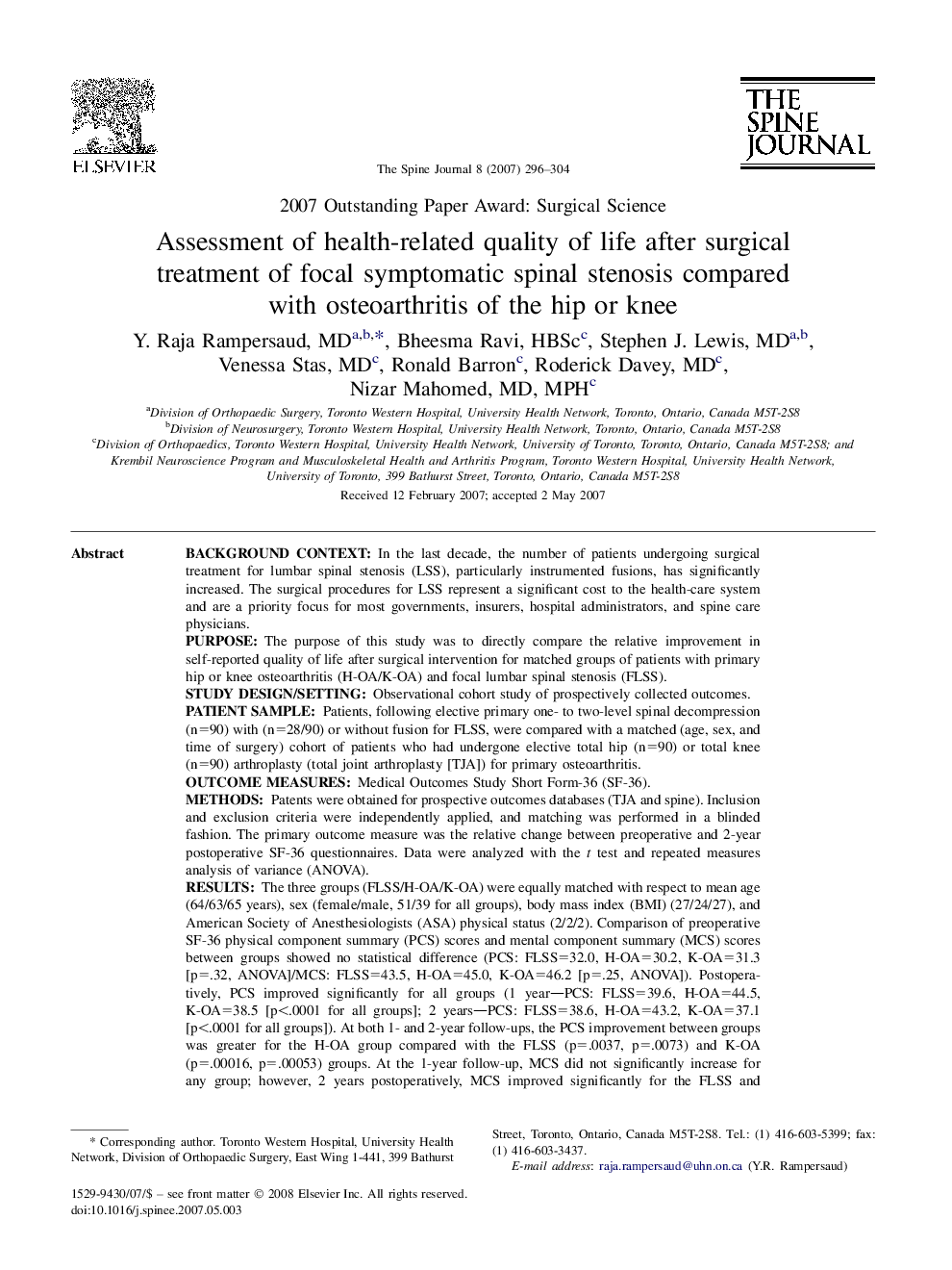| کد مقاله | کد نشریه | سال انتشار | مقاله انگلیسی | نسخه تمام متن |
|---|---|---|---|---|
| 4099332 | 1268637 | 2008 | 9 صفحه PDF | دانلود رایگان |

Background contextIn the last decade, the number of patients undergoing surgical treatment for lumbar spinal stenosis (LSS), particularly instrumented fusions, has significantly increased. The surgical procedures for LSS represent a significant cost to the health-care system and are a priority focus for most governments, insurers, hospital administrators, and spine care physicians.PurposeThe purpose of this study was to directly compare the relative improvement in self-reported quality of life after surgical intervention for matched groups of patients with primary hip or knee osteoarthritis (H-OA/K-OA) and focal lumbar spinal stenosis (FLSS).Study design/settingObservational cohort study of prospectively collected outcomes.Patient samplePatients, following elective primary one- to two-level spinal decompression (n=90) with (n=28/90) or without fusion for FLSS, were compared with a matched (age, sex, and time of surgery) cohort of patients who had undergone elective total hip (n=90) or total knee (n=90) arthroplasty (total joint arthroplasty [TJA]) for primary osteoarthritis.Outcome measuresMedical Outcomes Study Short Form-36 (SF-36).MethodsPatents were obtained for prospective outcomes databases (TJA and spine). Inclusion and exclusion criteria were independently applied, and matching was performed in a blinded fashion. The primary outcome measure was the relative change between preoperative and 2-year postoperative SF-36 questionnaires. Data were analyzed with the t test and repeated measures analysis of variance (ANOVA).ResultsThe three groups (FLSS/H-OA/K-OA) were equally matched with respect to mean age (64/63/65 years), sex (female/male, 51/39 for all groups), body mass index (BMI) (27/24/27), and American Society of Anesthesiologists (ASA) physical status (2/2/2). Comparison of preoperative SF-36 physical component summary (PCS) scores and mental component summary (MCS) scores between groups showed no statistical difference (PCS: FLSS=32.0, H-OA=30.2, K-OA=31.3 [p=.32, ANOVA]/MCS: FLSS=43.5, H-OA=45.0, K-OA=46.2 [p=.25, ANOVA]). Postoperatively, PCS improved significantly for all groups (1 year—PCS: FLSS=39.6, H-OA=44.5, K-OA=38.5 [p<.0001 for all groups]; 2 years—PCS: FLSS=38.6, H-OA=43.2, K-OA=37.1 [p<.0001 for all groups]). At both 1- and 2-year follow-ups, the PCS improvement between groups was greater for the H-OA group compared with the FLSS (p=.0037, p=.0073) and K-OA (p=.00016, p=.00053) groups. At the 1-year follow-up, MCS did not significantly increase for any group; however, 2 years postoperatively, MCS improved significantly for the FLSS and H-OA groups (2 years—MCS: FLSS=50.3, H-OA=50.9, K-OA=44.8 [p=.00021, p=.00079, p=.35]). At the 1-year follow-up, there was no statistical difference in MCS improvement between groups (p=.45, ANOVA). Two years postoperatively, the MCS for both the FLSS and H-OA groups was significantly greater than that for the K-OA group (p=.0014, p=.00055).ConclusionsThe results of this study show that surgical intervention for FLSS can obtain and maintain improvement in self-reported quality of life comparable to that of total hip and knee arthroplasty. This study provides data to support the need for prospective cost-effectiveness studies for the surgical management of appropriately selected patients suffering from FLSS.
Journal: The Spine Journal - Volume 8, Issue 2, March–April 2008, Pages 296–304